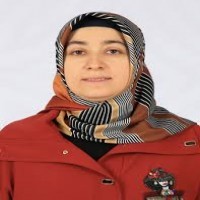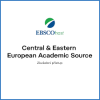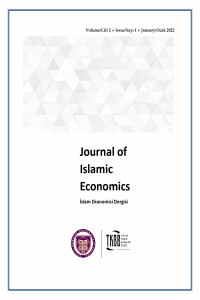Theoretical Article
Research Article
Aim & Scope
The journal aims to attract new lines of thinking that consider Islamic economics as one of the main components of economics, albeit with a distinctive methodology. It combines the reform of the received neoclassical doctrine as well as the contemporary system of market capitalism with alternative analytical approaches that reconstruct both our intellectual thought as well as our way of life. The journal is open to high-caliber research in economics, Islamic economics, finance and Islamic finance, history of economic thought, economic history, and other related fields, both theoretical and empirical.
Author Guidelines
Manuscript Layout: General
Authors must include:
• Article must be submitted only in Word version. The full title should not exceed 100 characters.
• The full title should not exceed 100 characters and abstract, must not exceed 250 words.
• A list of keywords (each word no more than 50 characters) indicating the contents of the article.
• The relevant JEL classification number(s) should be placed under the list of keywords.
• The full mailing and email address for the corresponding author at the bottom of the first page, before the acknowledgments.
• The affiliations of all authors at the end of the first page, before their mailing and email address.
• Please use American English throughout and double space the manuscript text.
• Use consecutive Arabic numerals in sections (such as 1, 2, 3); Papers should not include headers, footers, and page numbers
• ORCID must be added as a footnote.
Margins
• Paper Size: A4
• Top : 2.5 cm
• Bottom : 2.5 cm
• Left : 2.5 cm
• Right : 2.5 cm
• Gutter : 0”
• Gutter Position : Left
Title Page
• Paper title 14pt, bold and centered
• First letter of all words are capital
Author’s Name on the Title Page
• First letter of name and surname are capital, e.g. Burak Çıkıryel
• Centered
• Author’s info (title, affiliation, email address ve Orcid number) in the footnote on the title page, left aligned and 10pt
Abstract, Keywords, Jel Codes and the Main Text of the Paper
• Main Text of the Paper: Palatino Linotype font, 11pt, justified
• Paragrafh spacing: before and after 6pt, line spacing: 1,15
• Abstract, keywords, jel codes:
• Palatino Linotype font, 10pt, justified
• Paragrafh spacing: before and after 6pt, line spacing: 1,15
Heading
• Left aligned, title case, numbered (excluding introduction, results and references), bold
• Main headings and subheadings must numbered as follows: 1, 1.1, 1.1.1,…
Table, figure, graph, exhibit or chart: e.g. Table 1: Style Guide for Authors
• Numbered
• Above the table, figure, graph...
• Bold, e.g: Graph 1:
• Title case
Tables
Statistical tables should be clear-headed, and the reader should be able to understand the meaning of each row or column without searching in the text for explanations of symbols, etc. Units of measurement, base-dates for index numbers, geographical areas covered, and sources should be clearly stated. The authors are fully responsible for the accuracy of the data and for checking their proofs. Whenever the authors feel that the reader would have difficulty testing the derivation of their statistics, they should provide supplementary notes on the methods used.
• Ensure that tables are large enough to be clearly readable on an A4 page;
• Use consecutive Arabic numerals (such as 1, 2, 3);
• Use short titles in italics with initial capitals;
• Do not use vertical lines or shading;
• Do not use more than 10 columns per table.
Diagrams and figures
Diagrams and figures should be clearly drawn and accompanied by the basic statistics that were required for their preparation, the axes must be clearly labeled, and the reader must be able to understand the diagrams and figures without searching in the text for explanations. We reserve the right to request the worksheets used to produce all tables and figures.
Diagram and figure formatting
• Ensure that diagrams and figures are large enough to be clearly readable on an A4 page;
• Use consecutive Arabic numerals (such as 1, 2, 3);
• Use just a few round numbers in the axes;
• Diagrams and figures should be high-resolution;
• Diagram and figure legends must be clearly readable in black and white.
Mathematics
The mathematical derivations necessary for justifying each step of the argument should accompany all articles with mathematical arguments.
Please do not use smaller fonts in complex expressions, except for superscripts and subscripts.
• Numbers less than 1, but greater than -1 must have 0 before the decimal point.
• All equations to which the text refers should be numbered consecutively (1), (2), on the right-hand side of the page. Equations included within the main bulk of text should, where possible, be kept on one line. If equations contain fractions, a slash “/” (solidus) should be used and the numerator and denominator enclosed with parentheses.
• Algebra should include punctuation.
• Percent should appear in the text as %.
• Algebra should have bold capitals for matrices, bold lowercase for vectors, and italic lowercase for scalars.
• Transposition is denoted by a prime (A’).
• Fractions that are too complex to be kept within the text should be presented on a separate line.
• Assumptions, corollaries, definitions, lemmata, propositions, and theorems should each be consecutively numbered 1,2,3, etc. Each category should follow only from other numbers in that category (i.e., PROPOSITION 1, THEOREM 1, PROPOSITION 2, COROLLARY 1, THEOREM 2, PROPOSITION 3). Titles should be in small capitals, with the text following in italics. Algebra that does not follow the journal style will be queried during production.
Typesetting instructions should be provided in cases where ambiguities may arise. If there is a reason why the journal style may confuse the content of the article, authors are asked to add a note to the beginning of the text to explain why.
Footnotes
• Footnotes should be kept to a minimum;
• Use consecutive superscript Arabic numerals;
• Footnotes should appear after punctuation.
Acronyms
• First reference: Journal of Islamic Economics (JIE)
• Subsequent references: JIE
Quotations
• Short quotations ‘should be in single inverted commas with citation and page reference.’
• Long quotations should be separated from the main text, starting on a new line with a line space before and after. The paragraph should be indented. A citation should be included immediately under the quotation to the right.
Appendices
• Appendices should be designated A, B, C as required.
• Second level headings: A.1., A.2., B.1., etc.
• Tables and figures labeled as A1, A2, B1, B2, etc.
• Equations labeled as (A.1), (A.2), (B.1), etc.
References
References should start on a new page and must be
• Carefully checked and complete in respect of the year and the place of publication.
• A bibliographical list is given should follow the “American Psychological Association (APA) 6th edition” style.
• Given in alphabetical order, then chronological order for each author.
Ethical Principles and Publication Policy
Plagiarism
Manuscripts submitted may be screened with iThenticate anti-plagiarism software in an attempt to detect and prevent plagiarism. Any manuscript may be screened, especially if there is reason to suspect part or all of the text has been previously published. It is advisable to ensure that all references are fully and correctly cited throughout the paper on initial submission to the Journal. Prior to final acceptance, any manuscript that has not already been screened will be put through iThenticate. Any indication of plagiarism highlighted by our software may result in the revocation of an accept decision.
Disclosures
Permission for Reuse or Republication
Third-party permissions
Indexes
Journal Boards
Owner on behalf of the Social Sciences University of Ankara

Editor

Omer Faruk Tekdogan is an Associate Professor at the Institute for Islamic Studies, Social Sciences University of Ankara. He received his BA degree in business administration from İstanbul University and his master’s degree in economics from North Carolina State University. He completed his Ph.D. in Islamic Economics and Finance, at İstanbul University. Previously, he worked as Head of Department at Directorate General of Economic Programs and Research in the Ministry of Treasury and Finance, and as Policy Analyst in the Organization for Economic Co-operation and Development. His research interests include Islamic economics and finance, monetary economics, banking, financial economics, and agent-based modeling.
Co-Editor

Burak Çıkıryel is a Asst. Prof. Dr. at the Social Sciences University of Ankara in the Department of Islamic Economics and Finance. He graduated from Uludağ University, Department of Economics, in 2013. He completed his Master in Islamic Finance from International Centre for Education in Islamic Finance (INCEIF) in 2017 in Kuala Lumpur, Malaysia. He completed his PhD at Sakarya Univesity, Department of Islamic Economics and Finance. He is the Co-Editor of the “Journal of Islamic Economics.” He has conducted numerous academic projects, publications, and conferences in the areas of his research interests, including macroeconomic policy, banking, and finance aspects under the domain of Islamic economics. He is actively taking on various roles in non-governmental organizations, managing projects, and striving to engage in activities that benefit the community.

Dr. Ozat Shamshiyev is an Assistant Professor at the Social Sciences University of Ankara (Department of Islamic Economics and Finance) and the Deputy Director of the ASBU International Center for Islamic Economics and Finance (ULIFAM). He also serves as the Co-Editor of the Journal of Islamic Economics, with its Editor-in-Chief being the renowned scholar and pioneer of Islamic economics, Prof. Dr. Mabid Ali Al-Jarhi.
He graduated from the Faculty of Theology at Necmettin Erbakan University in 2013 and earned an associate degree in International Trade from Anadolu University in 2014. He completed his master’s degree in Islamic Sciences at Erciyes University in 2017 and obtained his PhD in Islamic Contract Law from Necmettin Erbakan University in 2022.
He has authored and edited several books and published numerous research papers on Islamic law, Islamic economics, and finance. He speaks English, Arabic, Turkish, Russian, and his native Kazakh. Dr. Shamshiyev is married and a father of three children.
Editorial Board


Advisory Board




English Language Editor and Proofreader


Academic Background:
Ph.D. Yarmouk University (Jordan), Irbid City, Economy and Islamic Banking, 2007.
M.D. Yarmouk University (Jordan), Irbid City, Islamic Economy, 1999.
B.A. Jordan University (Jordan) Amman, Islamic Studies—Sharia, 1987.
Bio: Dr Adnan Abdalla Mohammad Oweida is Assistant Professor, he used to work as an academic, education supervisor and researcher, where he worked as an educational supervisor for the humanities, social sciences, Islamic sciences, and the Arabic language, where he worked in the United Nations Education Program on UNRWA from 1995 to 2017. He also worked as a trainer and academic instructor at Wadi ALseer College, Zarqa University, Zayed University Abu Dhabi, and now he works at Ankara University of Social Sciences. He has received many technical courses in preparing teachers, teaching methods and methods of educational supervision, as well as many courses and fellowships in preparing educational and procedural research. Dr Awaida has dual interests in economics, educational economics and Islamic finance. He has prepared many books and research papers and participated in many conferences.
French Language Editor and Proofreader

Ezzedine GHLAMALLAH is a researcher and a consultant, cofounder of SAAFI, an insurance brokerage and financial advisory firm specialized in the conception and distribution of Takaful and Islamic finance solutions.
He designed Takaful and Islamic finance solutions in the European market and advised firms and organizations wishing to structure Takaful or Islamic finance projects in Africa.
He conducted strategic feasibility studies for banks and insurance companies to implement Family Takaful in France and North Africa.
He graduated from The University of Law and Political Sciences of Strasbourg, where he earned his Executive MBA Islamic Finance and obtained a Master in Finance, Accounting, Tax System, and Wealth Management from the University of Aix-Marseille; he is also an alumnus of the National School of Insurance of Paris, graduated in Banking, Finance, and Insurance.
He completed his Ph.D. at Aix-Marseille University. His research focuses on sustainable development, sustainable finance, RSI, CSR, Islamic economics, Islamic finance, and Takaful.
Arabic Language Editor and Proofreader

Turkish Language Editor and Proofreader

Layout Editor

Statistical Editor
Secretariat



Sakarya Üniversitesi İlahiyat fakültesi mezunuyum. İslam Ekonomisi ve Finansı alanında yüksek lisansımı tamamlamış bir akademisyenim. Akademik yazışmalar, içerik düzenleme, makale değerlendirme süreçlerinin koordinasyonu ve iletişim konularında deneyim sahibiyim. Arapça'ya yetkinliğim sayesinde İslam Ekonomisi Dergisi'nde uluslararası akademik çalışmalara katkıda bulunuyorum.
Section Editors (Islamic Economics)

İsa Yılmaz holds a bachelor's degree in Economics and Management from Istanbul Bilgi University and participated in the University of London double degree program, receiving academic guidance from the London School of Economics and Political Science (LSE). He pursued his master's degree in Islamic Finance at the University of Durham (UK) and completed his Ph.D. in Islamic Finance from the same institution. Currently, he serves as an associate professor in the Economics Department at Istanbul Medeniyet University. He has published several academic papers on economic development, financialization and aspects of political economy in Islamic economics. In a broader context, he explores alternative economic and financial systems that strive to envision authentic models with positive developmental and welfare outcomes for emerging economies. To explore these areas, he engages with the literature on the moral economy, political economy, philosophy of economics, and alternative banking and financial models.

Erhan Akkas is currently an assistant professor at Sakarya University in Turkey. He graduated from Durham University with a Ph.D. in Islamic economics and finance in 2019, after obtaining his master’s in political economy from the University of Sussex. Akkas was a visiting research fellow at Durham University Business School as well as a lecturer at Agri Ibrahim Cecen University in Turkey between 2020 and 2022. An associate professorship was granted to him in February 2023 by the Turkish Interuniversity Board (ÜAK). Akkas has written many academic papers, policy briefs, and edited books. Akkas' most recent research focuses on political economy, Islamic economics, Islamic finance, economic develpment, and GCC countries.

 Web
Web
Maliye ve sosyoloji lisans eğitiminin ardından iktisat ve din sosyolojisi alanlarında yüksek lisans eğitimini tamamlamıştır. Bankacılık sektörü ve özel sektörde muhtelif görevler üstlenmiştir. İstanbul Sabahattin Zaim Üniversitesi İslam Ekonomisi ve Uluslararası Finans Programında doktorasını tamamlayan Yunus Emre Aydınbaş işgal ettiği akademik pozisyonlarda araştırmalarına devam etmektedir. Çalışmaları İslami iktisat metodolojisi, İslami iktisat düşüncesi, İslami ekonomide mali yapı ve vergi sistemi, ahlâk ve iktisat konuları etrafında yoğunlaşmaktadır. 04/04/2024

Assoc. Prof. Dr. Muhammet Fatih CANBAZ
Originally from Zonguldak, Muhammet Fatih Canbaz was born in 1984 in the Fatih district of Istanbul. He graduated from the Faculty of Economics and Administrative Sciences at Dumlupınar University (Bilecik) in 2007, after which he gained professional experience in the private financial sector. In 2008, he began his career in participation banking, serving in various branch and head office positions until 2014.
He completed his Master’s thesis in Business Administration in the joint program of Kırklareli University and Marmara University in 2013, and earned his Ph.D. in Business Administration from Afyon Kocatepe University in 2019.
In 2014, Canbaz was appointed as a lecturer at Afyon Kocatepe University, marking the start of his academic career. In 2021, he joined Bolu Abant Izzet Baysal University, Department of Finance and Banking, as a faculty member. He was awarded the title of Associate Professor in the field of Islamic Finance in 2023.
He currently teaches undergraduate and graduate courses in Islamic Economics and Finance, Participation Banking, Finance, and Behavioral Finance at Bolu Abant Izzet Baysal University.
He is married and the father of three sons.

Ozan Maraşlı completed his BSc in Business Administration at İhsan Doğramacı Bilkent University in 2014 and MA in Economics at Istanbul Technical University in 2018. Then he completed his Ph.D. in Islamic Economics and Finance at Istanbul Sabahattin Zaim University in 2022. He is currently working in the Institute of Islamic Economics and Finance at Marmara University. His fields of interest are zakat, waqf and Islamic public finance.
Section Editors (Islamic Finance)



Murat Yaş Marmara Üniversitesi İslam Ekonomisi ve Finansı Enstitüsü'nde Dr. Öğretim Üyesi olarak görev yapmaktadır. Ayrıca Japonya'da Sophia Üniversitesi Asya, Afrika ve Ortadoğu Çalışmaları Enstitüsü'nde Ziyaretçi Araştırmacı olarak bulunmuştur. Yüksek Lisans ve Doktora eğitimini Malezya'da INCEIF Üniversitesi'nde İslami Finans alanında tamamlamış ve lisans derecesini Ekonomi alanında Boğaziçi Üniversitesi'nden almıştır. Ayrıca, İngiltere'de Reading Üniversitesi'nde ICMA Centre’da ziyaretçi yüksek lisans öğrencisi olarak bulunmuştur.
Araştırma alanları finansal piyasalar, İslami finans ve Asya çalışmalarıdır.
14 yılı bankacılık, 4,5 yılı özel sektör kuruluşları ve kamu kurumlarında mali ve finansal yönetimden sorumlu üst düzey yönetici olarak görev yaptım. Finansal yönetim alanında 18,5 yıllık saha tecrübem bulunmaktadır. Saha tecrübemi akademik çalışmalarla bütünleştirmeyi amaçlamaktayım.

Assoc. Prof. Dr. Muhammet Fatih CANBAZ
Originally from Zonguldak, Muhammet Fatih Canbaz was born in 1984 in the Fatih district of Istanbul. He graduated from the Faculty of Economics and Administrative Sciences at Dumlupınar University (Bilecik) in 2007, after which he gained professional experience in the private financial sector. In 2008, he began his career in participation banking, serving in various branch and head office positions until 2014.
He completed his Master’s thesis in Business Administration in the joint program of Kırklareli University and Marmara University in 2013, and earned his Ph.D. in Business Administration from Afyon Kocatepe University in 2019.
In 2014, Canbaz was appointed as a lecturer at Afyon Kocatepe University, marking the start of his academic career. In 2021, he joined Bolu Abant Izzet Baysal University, Department of Finance and Banking, as a faculty member. He was awarded the title of Associate Professor in the field of Islamic Finance in 2023.
He currently teaches undergraduate and graduate courses in Islamic Economics and Finance, Participation Banking, Finance, and Behavioral Finance at Bolu Abant Izzet Baysal University.
He is married and the father of three sons.

Dr. Güney graduated from the Faculty of Theology at Selçuk University in 2003. He began his academic career as a research assistant in Islamic Law at the same faculty in 2005. In 2006, he completed his Master's thesis in Islamic Law, and in 2013, he finished his doctoral dissertation on Islamic law of obligations. While pursuing his PhD, he also graduated from Anadolu University with a degree in Economics through the Open Education program.
Dr. Güney has served as a visiting researcher at Columbia University in New York for one year in 2009 and at the Islamic Research and Training Institute (IRT) in Jeddah for two months in 2018. He was promoted to Associate Professor in 2020. He currently serves as a faculty member in the Department of Islamic Law at Necmettin Erbakan University and also teaches as a visiting faculty member in the Department of Islamic Economics and Finance at KTO Karatay University.
Section Editors (Islamic Microfinance)



2011 yılında Ankara Üniversitesi Siyasal Bilgiler Fakültesi İşletme Bölümünden, Yüksek lisansını, 2016 yılında Sakarya Üniversitesi İslam Ekonomisi ve Finansı anabilim dalında “Borsa İstanbul Katılım Endeksinin Piyasa Faiz Oranları ile İlişkisi ve Performansının Analizi” başlıklı teziyle tamamladı. 2020 yılında ise Sakarya Üniversitesi İlahiyat Fakültesinde ikinci lisansını tamamladı. 2021 yılında aynı anabilim dalında “İslami Mikrofinans Programlarının Etkinliği: İksar Karz-ı Hasen Örneği” başlıklı tez çalışmasıyla doktorasını tamamladı. 2014-2021 yılları Sakarya Üniversitesi İslam Ekonomisi ve Finansı Uygulama ve Araştırma Merkezinde araştırma görevlisi olarak çalıştı. Halen Sakarya Üniversitesi Siyasal Bilgiler Fakültesi, İslam iktisadı ve finans bölümünde Doçent olarak görev yapmaktadır.

Murat Yaş Marmara Üniversitesi İslam Ekonomisi ve Finansı Enstitüsü'nde Dr. Öğretim Üyesi olarak görev yapmaktadır. Ayrıca Japonya'da Sophia Üniversitesi Asya, Afrika ve Ortadoğu Çalışmaları Enstitüsü'nde Ziyaretçi Araştırmacı olarak bulunmuştur. Yüksek Lisans ve Doktora eğitimini Malezya'da INCEIF Üniversitesi'nde İslami Finans alanında tamamlamış ve lisans derecesini Ekonomi alanında Boğaziçi Üniversitesi'nden almıştır. Ayrıca, İngiltere'de Reading Üniversitesi'nde ICMA Centre’da ziyaretçi yüksek lisans öğrencisi olarak bulunmuştur.
Araştırma alanları finansal piyasalar, İslami finans ve Asya çalışmalarıdır.

Assoc. Prof. Dr. Muhammet Fatih CANBAZ
Originally from Zonguldak, Muhammet Fatih Canbaz was born in 1984 in the Fatih district of Istanbul. He graduated from the Faculty of Economics and Administrative Sciences at Dumlupınar University (Bilecik) in 2007, after which he gained professional experience in the private financial sector. In 2008, he began his career in participation banking, serving in various branch and head office positions until 2014.
He completed his Master’s thesis in Business Administration in the joint program of Kırklareli University and Marmara University in 2013, and earned his Ph.D. in Business Administration from Afyon Kocatepe University in 2019.
In 2014, Canbaz was appointed as a lecturer at Afyon Kocatepe University, marking the start of his academic career. In 2021, he joined Bolu Abant Izzet Baysal University, Department of Finance and Banking, as a faculty member. He was awarded the title of Associate Professor in the field of Islamic Finance in 2023.
He currently teaches undergraduate and graduate courses in Islamic Economics and Finance, Participation Banking, Finance, and Behavioral Finance at Bolu Abant Izzet Baysal University.
He is married and the father of three sons.
Section Editors (Islamic Banking)
She was born in Manisa. After completing secondary school in Manisa Anatolian Imam Hatip High School, she graduated from Open Education High School. Orhan, who graduated from Bahçeşehir University, Department of Economics (with full scholarship) in her undergraduate education, completed her master’s degree in International and EU Relations at Linköping University in Sweden with a Swedish Institute scholarship. Then she received her PhD in Economics from the International University of Sarajevo. Her doctoral dissertation deals with the risk analysis of profit and loss sharing instruments in Islamic banking (participation banking). She has been working at Istanbul Sabahattin Zaim University, Faculty of Business and Management Sciences since Fall 2015. The main areas of work Orhan, who received the title of associate professor in the field of banking and insurance, are comparative finance and banking, and the connection of Islamic finance and banking with the Islamic economy.

Murat Yaş Marmara Üniversitesi İslam Ekonomisi ve Finansı Enstitüsü'nde Dr. Öğretim Üyesi olarak görev yapmaktadır. Ayrıca Japonya'da Sophia Üniversitesi Asya, Afrika ve Ortadoğu Çalışmaları Enstitüsü'nde Ziyaretçi Araştırmacı olarak bulunmuştur. Yüksek Lisans ve Doktora eğitimini Malezya'da INCEIF Üniversitesi'nde İslami Finans alanında tamamlamış ve lisans derecesini Ekonomi alanında Boğaziçi Üniversitesi'nden almıştır. Ayrıca, İngiltere'de Reading Üniversitesi'nde ICMA Centre’da ziyaretçi yüksek lisans öğrencisi olarak bulunmuştur.
Araştırma alanları finansal piyasalar, İslami finans ve Asya çalışmalarıdır.
14 yılı bankacılık, 4,5 yılı özel sektör kuruluşları ve kamu kurumlarında mali ve finansal yönetimden sorumlu üst düzey yönetici olarak görev yaptım. Finansal yönetim alanında 18,5 yıllık saha tecrübem bulunmaktadır. Saha tecrübemi akademik çalışmalarla bütünleştirmeyi amaçlamaktayım.


Assoc. Prof. Dr. Muhammet Fatih CANBAZ
Originally from Zonguldak, Muhammet Fatih Canbaz was born in 1984 in the Fatih district of Istanbul. He graduated from the Faculty of Economics and Administrative Sciences at Dumlupınar University (Bilecik) in 2007, after which he gained professional experience in the private financial sector. In 2008, he began his career in participation banking, serving in various branch and head office positions until 2014.
He completed his Master’s thesis in Business Administration in the joint program of Kırklareli University and Marmara University in 2013, and earned his Ph.D. in Business Administration from Afyon Kocatepe University in 2019.
In 2014, Canbaz was appointed as a lecturer at Afyon Kocatepe University, marking the start of his academic career. In 2021, he joined Bolu Abant Izzet Baysal University, Department of Finance and Banking, as a faculty member. He was awarded the title of Associate Professor in the field of Islamic Finance in 2023.
He currently teaches undergraduate and graduate courses in Islamic Economics and Finance, Participation Banking, Finance, and Behavioral Finance at Bolu Abant Izzet Baysal University.
He is married and the father of three sons.
Section Editors (Takaful)

Doç. Dr. Hakan Aslan, Sakarya Üniversitesi İslam İktisadı ve Finans Bölümü'nde görev yapmaktadır.

Yunus Emre Gürbüz, İstanbul Üniversitesi, İktisat Fakültesi, İktisat Bölümü’nden mezun olduktan sonra 2004 yılından itibaren Türkiye Finans Katılım Bankası, Bereket Sigorta ve Yıldız Holding (Ülker)’de denetçi olarak görev yapmıştır. Ardından 2010 yılında Türkiye’nin ilk katılım sigorta şirketi olan Neova Sigorta’nın kurucuları arasında yer alıp, 12 yıl boyunca İç Denetim Başkanı olarak görev icra etmiştir.
Türkiye Sigorta Birliği (TSB) nezdinde bulunan Katılım Sigortacılığı Komitesi’nin de 2018-2020 dönem başkanlıkları görevini yürütmüştür. Sigortacılıkla ve hususan tekaful konusunda çok sayıda kitap ve makalesi olan Gürbüz’ün, yüze yakın da ulusal, uluslararası konferans, çalıştay, panel ve kongrelerde tebliğleri, konuşmaları olmuştur. Cumhurbaşkanlığı İslami Finans Strateji Belgelerinin sigortacılık kısmının hazırlanmasında ve yine Cumhurbaşkanlığı Kalkınma Planlarında da komisyon üyelikleri mevcuttur.
Hali hazırda kuruluş aşamasında olan Pay Katılım Sigorta’nın hasar, insan kaynakları ve iletişimden sorumlu genel müdür yardımcılığını yapan Gürbüz, 2014 yılında kurulan Katılım Sigortacılığı Derneği’nin yönetim kurulu üyesi ve genel sekreterliğini de yürütmektedir. Gürbüz, aynı zamanda ülkemizde katılım finansın gelişimi için de çeşitli üniversitelerde İslam iktisadı ve finansı dersleri de vermektedir.
Section Editors (Islamic Financial Markets)

Murat Yaş Marmara Üniversitesi İslam Ekonomisi ve Finansı Enstitüsü'nde Dr. Öğretim Üyesi olarak görev yapmaktadır. Ayrıca Japonya'da Sophia Üniversitesi Asya, Afrika ve Ortadoğu Çalışmaları Enstitüsü'nde Ziyaretçi Araştırmacı olarak bulunmuştur. Yüksek Lisans ve Doktora eğitimini Malezya'da INCEIF Üniversitesi'nde İslami Finans alanında tamamlamış ve lisans derecesini Ekonomi alanında Boğaziçi Üniversitesi'nden almıştır. Ayrıca, İngiltere'de Reading Üniversitesi'nde ICMA Centre’da ziyaretçi yüksek lisans öğrencisi olarak bulunmuştur.
Araştırma alanları finansal piyasalar, İslami finans ve Asya çalışmalarıdır.
14 yılı bankacılık, 4,5 yılı özel sektör kuruluşları ve kamu kurumlarında mali ve finansal yönetimden sorumlu üst düzey yönetici olarak görev yaptım. Finansal yönetim alanında 18,5 yıllık saha tecrübem bulunmaktadır. Saha tecrübemi akademik çalışmalarla bütünleştirmeyi amaçlamaktayım.
Section Editors (Public Finance in Islamic Economics)

 Web
Web
Maliye ve sosyoloji lisans eğitiminin ardından iktisat ve din sosyolojisi alanlarında yüksek lisans eğitimini tamamlamıştır. Bankacılık sektörü ve özel sektörde muhtelif görevler üstlenmiştir. İstanbul Sabahattin Zaim Üniversitesi İslam Ekonomisi ve Uluslararası Finans Programında doktorasını tamamlayan Yunus Emre Aydınbaş işgal ettiği akademik pozisyonlarda araştırmalarına devam etmektedir. Çalışmaları İslami iktisat metodolojisi, İslami iktisat düşüncesi, İslami ekonomide mali yapı ve vergi sistemi, ahlâk ve iktisat konuları etrafında yoğunlaşmaktadır. 04/04/2024
Section Editors (Islamic Fintech)

Assoc. Prof. Dr. Muhammet Fatih CANBAZ
Originally from Zonguldak, Muhammet Fatih Canbaz was born in 1984 in the Fatih district of Istanbul. He graduated from the Faculty of Economics and Administrative Sciences at Dumlupınar University (Bilecik) in 2007, after which he gained professional experience in the private financial sector. In 2008, he began his career in participation banking, serving in various branch and head office positions until 2014.
He completed his Master’s thesis in Business Administration in the joint program of Kırklareli University and Marmara University in 2013, and earned his Ph.D. in Business Administration from Afyon Kocatepe University in 2019.
In 2014, Canbaz was appointed as a lecturer at Afyon Kocatepe University, marking the start of his academic career. In 2021, he joined Bolu Abant Izzet Baysal University, Department of Finance and Banking, as a faculty member. He was awarded the title of Associate Professor in the field of Islamic Finance in 2023.
He currently teaches undergraduate and graduate courses in Islamic Economics and Finance, Participation Banking, Finance, and Behavioral Finance at Bolu Abant Izzet Baysal University.
He is married and the father of three sons.
Section Editors (Shariah Governance)

Murat Yaş Marmara Üniversitesi İslam Ekonomisi ve Finansı Enstitüsü'nde Dr. Öğretim Üyesi olarak görev yapmaktadır. Ayrıca Japonya'da Sophia Üniversitesi Asya, Afrika ve Ortadoğu Çalışmaları Enstitüsü'nde Ziyaretçi Araştırmacı olarak bulunmuştur. Yüksek Lisans ve Doktora eğitimini Malezya'da INCEIF Üniversitesi'nde İslami Finans alanında tamamlamış ve lisans derecesini Ekonomi alanında Boğaziçi Üniversitesi'nden almıştır. Ayrıca, İngiltere'de Reading Üniversitesi'nde ICMA Centre’da ziyaretçi yüksek lisans öğrencisi olarak bulunmuştur.
Araştırma alanları finansal piyasalar, İslami finans ve Asya çalışmalarıdır.
Section Editors (Business Administration and Management)

Section Editors (Islamic Crowdfunding)

Assoc. Prof. Dr. Muhammet Fatih CANBAZ
Originally from Zonguldak, Muhammet Fatih Canbaz was born in 1984 in the Fatih district of Istanbul. He graduated from the Faculty of Economics and Administrative Sciences at Dumlupınar University (Bilecik) in 2007, after which he gained professional experience in the private financial sector. In 2008, he began his career in participation banking, serving in various branch and head office positions until 2014.
He completed his Master’s thesis in Business Administration in the joint program of Kırklareli University and Marmara University in 2013, and earned his Ph.D. in Business Administration from Afyon Kocatepe University in 2019.
In 2014, Canbaz was appointed as a lecturer at Afyon Kocatepe University, marking the start of his academic career. In 2021, he joined Bolu Abant Izzet Baysal University, Department of Finance and Banking, as a faculty member. He was awarded the title of Associate Professor in the field of Islamic Finance in 2023.
He currently teaches undergraduate and graduate courses in Islamic Economics and Finance, Participation Banking, Finance, and Behavioral Finance at Bolu Abant Izzet Baysal University.
He is married and the father of three sons.
Section Editors (Islamic Asset Management)
14 yılı bankacılık, 4,5 yılı özel sektör kuruluşları ve kamu kurumlarında mali ve finansal yönetimden sorumlu üst düzey yönetici olarak görev yaptım. Finansal yönetim alanında 18,5 yıllık saha tecrübem bulunmaktadır. Saha tecrübemi akademik çalışmalarla bütünleştirmeyi amaçlamaktayım.
Section Editors (Islamic Economic Thought)

Cem Korkut, Ankara Yıldırım Beyazıt Üniversitesi (AYBÜ), Siyasal Bilgiler Fakültesi, İktisat Bölümü’nde Doç. Dr. olarak görev yapmaktadır. Ayrıca Türkiye Bilimler Akademisi’nde (TÜBA) Başkan danışmanı olarak çalışmaktadır. Lisansını, Türkiye derecesi ile burslu olarak girdiği TOBB Ekonomi ve Teknoloji Üniversitesi (TOBB ETÜ) İktisat bölümünde yüksek onur öğrencisi olarak tamamlamıştır. 2011 yılında araştırma görevlisi olarak başladığı AYBÜ’de 2014’te bitirdiği yüksek lisans tezinde günümüzdeki İslami finans kurumlarının öncüsü olarak nitelenen para vakıfları üzerine çalışmıştır. İstanbul Sabahattin Zaim Üniversitesi’nde (İZÜ) İslam ekonomisinde sermaye oluşumu, birikimi ve yapısı konusundaki tezi ile doktora derecesi almıştır. İslam ekonomisi, İslami bankacılık ve finans, para vakıfları gibi konularda yayımlanmış ulusal ve uluslararası makaleleri, kitap bölümleri bulunan Dr. Korkut aynı zamanda Ankara Düşünce ve Araştırma Merkezi’nin (ADAM) aktif bir üyesi olup bu merkezdeki İslam Ekonomisi Okulu’nun yürütücüsüdür. Akademik ilgi alanları İslam Ekonomisi, İslami Bankacılık ve Finans, Makroekonomik Politikalar, Uzun-dönem Dünya Ekonomisi, Osmanlı İktisat Tarihi ve İktisadi Kalkınma'dır.

Ozan Maraşlı completed his BSc in Business Administration at İhsan Doğramacı Bilkent University in 2014 and MA in Economics at Istanbul Technical University in 2018. Then he completed his Ph.D. in Islamic Economics and Finance at Istanbul Sabahattin Zaim University in 2022. He is currently working in the Institute of Islamic Economics and Finance at Marmara University. His fields of interest are zakat, waqf and Islamic public finance.

 Web
Web
Maliye ve sosyoloji lisans eğitiminin ardından iktisat ve din sosyolojisi alanlarında yüksek lisans eğitimini tamamlamıştır. Bankacılık sektörü ve özel sektörde muhtelif görevler üstlenmiştir. İstanbul Sabahattin Zaim Üniversitesi İslam Ekonomisi ve Uluslararası Finans Programında doktorasını tamamlayan Yunus Emre Aydınbaş işgal ettiği akademik pozisyonlarda araştırmalarına devam etmektedir. Çalışmaları İslami iktisat metodolojisi, İslami iktisat düşüncesi, İslami ekonomide mali yapı ve vergi sistemi, ahlâk ve iktisat konuları etrafında yoğunlaşmaktadır. 04/04/2024
Section Editors (Cooperative and Agriculture)

Section Editors (Islamic Social Finance)

Cem Korkut, Ankara Yıldırım Beyazıt Üniversitesi (AYBÜ), Siyasal Bilgiler Fakültesi, İktisat Bölümü’nde Doç. Dr. olarak görev yapmaktadır. Ayrıca Türkiye Bilimler Akademisi’nde (TÜBA) Başkan danışmanı olarak çalışmaktadır. Lisansını, Türkiye derecesi ile burslu olarak girdiği TOBB Ekonomi ve Teknoloji Üniversitesi (TOBB ETÜ) İktisat bölümünde yüksek onur öğrencisi olarak tamamlamıştır. 2011 yılında araştırma görevlisi olarak başladığı AYBÜ’de 2014’te bitirdiği yüksek lisans tezinde günümüzdeki İslami finans kurumlarının öncüsü olarak nitelenen para vakıfları üzerine çalışmıştır. İstanbul Sabahattin Zaim Üniversitesi’nde (İZÜ) İslam ekonomisinde sermaye oluşumu, birikimi ve yapısı konusundaki tezi ile doktora derecesi almıştır. İslam ekonomisi, İslami bankacılık ve finans, para vakıfları gibi konularda yayımlanmış ulusal ve uluslararası makaleleri, kitap bölümleri bulunan Dr. Korkut aynı zamanda Ankara Düşünce ve Araştırma Merkezi’nin (ADAM) aktif bir üyesi olup bu merkezdeki İslam Ekonomisi Okulu’nun yürütücüsüdür. Akademik ilgi alanları İslam Ekonomisi, İslami Bankacılık ve Finans, Makroekonomik Politikalar, Uzun-dönem Dünya Ekonomisi, Osmanlı İktisat Tarihi ve İktisadi Kalkınma'dır.

Ozan Maraşlı completed his BSc in Business Administration at İhsan Doğramacı Bilkent University in 2014 and MA in Economics at Istanbul Technical University in 2018. Then he completed his Ph.D. in Islamic Economics and Finance at Istanbul Sabahattin Zaim University in 2022. He is currently working in the Institute of Islamic Economics and Finance at Marmara University. His fields of interest are zakat, waqf and Islamic public finance.
14 yılı bankacılık, 4,5 yılı özel sektör kuruluşları ve kamu kurumlarında mali ve finansal yönetimden sorumlu üst düzey yönetici olarak görev yaptım. Finansal yönetim alanında 18,5 yıllık saha tecrübem bulunmaktadır. Saha tecrübemi akademik çalışmalarla bütünleştirmeyi amaçlamaktayım.


Assoc. Prof. Dr. Muhammet Fatih CANBAZ
Originally from Zonguldak, Muhammet Fatih Canbaz was born in 1984 in the Fatih district of Istanbul. He graduated from the Faculty of Economics and Administrative Sciences at Dumlupınar University (Bilecik) in 2007, after which he gained professional experience in the private financial sector. In 2008, he began his career in participation banking, serving in various branch and head office positions until 2014.
He completed his Master’s thesis in Business Administration in the joint program of Kırklareli University and Marmara University in 2013, and earned his Ph.D. in Business Administration from Afyon Kocatepe University in 2019.
In 2014, Canbaz was appointed as a lecturer at Afyon Kocatepe University, marking the start of his academic career. In 2021, he joined Bolu Abant Izzet Baysal University, Department of Finance and Banking, as a faculty member. He was awarded the title of Associate Professor in the field of Islamic Finance in 2023.
He currently teaches undergraduate and graduate courses in Islamic Economics and Finance, Participation Banking, Finance, and Behavioral Finance at Bolu Abant Izzet Baysal University.
He is married and the father of three sons.
Section Editors (International Trade and Finance)


Section Editors (Behavioral Economics and Finance)

Assoc. Prof. Dr. Muhammet Fatih CANBAZ
Originally from Zonguldak, Muhammet Fatih Canbaz was born in 1984 in the Fatih district of Istanbul. He graduated from the Faculty of Economics and Administrative Sciences at Dumlupınar University (Bilecik) in 2007, after which he gained professional experience in the private financial sector. In 2008, he began his career in participation banking, serving in various branch and head office positions until 2014.
He completed his Master’s thesis in Business Administration in the joint program of Kırklareli University and Marmara University in 2013, and earned his Ph.D. in Business Administration from Afyon Kocatepe University in 2019.
In 2014, Canbaz was appointed as a lecturer at Afyon Kocatepe University, marking the start of his academic career. In 2021, he joined Bolu Abant Izzet Baysal University, Department of Finance and Banking, as a faculty member. He was awarded the title of Associate Professor in the field of Islamic Finance in 2023.
He currently teaches undergraduate and graduate courses in Islamic Economics and Finance, Participation Banking, Finance, and Behavioral Finance at Bolu Abant Izzet Baysal University.
He is married and the father of three sons.
Section Editors (Accounting)

Section Editors (Economies of Islamic Countries)

Erhan Akkas is currently an assistant professor at Sakarya University in Turkey. He graduated from Durham University with a Ph.D. in Islamic economics and finance in 2019, after obtaining his master’s in political economy from the University of Sussex. Akkas was a visiting research fellow at Durham University Business School as well as a lecturer at Agri Ibrahim Cecen University in Turkey between 2020 and 2022. An associate professorship was granted to him in February 2023 by the Turkish Interuniversity Board (ÜAK). Akkas has written many academic papers, policy briefs, and edited books. Akkas' most recent research focuses on political economy, Islamic economics, Islamic finance, economic develpment, and GCC countries.

Section Editors (Islamic Moral Economy)

İsa Yılmaz holds a bachelor's degree in Economics and Management from Istanbul Bilgi University and participated in the University of London double degree program, receiving academic guidance from the London School of Economics and Political Science (LSE). He pursued his master's degree in Islamic Finance at the University of Durham (UK) and completed his Ph.D. in Islamic Finance from the same institution. Currently, he serves as an associate professor in the Economics Department at Istanbul Medeniyet University. He has published several academic papers on economic development, financialization and aspects of political economy in Islamic economics. In a broader context, he explores alternative economic and financial systems that strive to envision authentic models with positive developmental and welfare outcomes for emerging economies. To explore these areas, he engages with the literature on the moral economy, political economy, philosophy of economics, and alternative banking and financial models.

Erhan Akkas is currently an assistant professor at Sakarya University in Turkey. He graduated from Durham University with a Ph.D. in Islamic economics and finance in 2019, after obtaining his master’s in political economy from the University of Sussex. Akkas was a visiting research fellow at Durham University Business School as well as a lecturer at Agri Ibrahim Cecen University in Turkey between 2020 and 2022. An associate professorship was granted to him in February 2023 by the Turkish Interuniversity Board (ÜAK). Akkas has written many academic papers, policy briefs, and edited books. Akkas' most recent research focuses on political economy, Islamic economics, Islamic finance, economic develpment, and GCC countries.

 Web
Web
Maliye ve sosyoloji lisans eğitiminin ardından iktisat ve din sosyolojisi alanlarında yüksek lisans eğitimini tamamlamıştır. Bankacılık sektörü ve özel sektörde muhtelif görevler üstlenmiştir. İstanbul Sabahattin Zaim Üniversitesi İslam Ekonomisi ve Uluslararası Finans Programında doktorasını tamamlayan Yunus Emre Aydınbaş işgal ettiği akademik pozisyonlarda araştırmalarına devam etmektedir. Çalışmaları İslami iktisat metodolojisi, İslami iktisat düşüncesi, İslami ekonomide mali yapı ve vergi sistemi, ahlâk ve iktisat konuları etrafında yoğunlaşmaktadır. 04/04/2024
Section Editors

2011 yılında Ankara Üniversitesi Siyasal Bilgiler Fakültesi İşletme Bölümünden, Yüksek lisansını, 2016 yılında Sakarya Üniversitesi İslam Ekonomisi ve Finansı anabilim dalında “Borsa İstanbul Katılım Endeksinin Piyasa Faiz Oranları ile İlişkisi ve Performansının Analizi” başlıklı teziyle tamamladı. 2020 yılında ise Sakarya Üniversitesi İlahiyat Fakültesinde ikinci lisansını tamamladı. 2021 yılında aynı anabilim dalında “İslami Mikrofinans Programlarının Etkinliği: İksar Karz-ı Hasen Örneği” başlıklı tez çalışmasıyla doktorasını tamamladı. 2014-2021 yılları Sakarya Üniversitesi İslam Ekonomisi ve Finansı Uygulama ve Araştırma Merkezinde araştırma görevlisi olarak çalıştı. Halen Sakarya Üniversitesi Siyasal Bilgiler Fakültesi, İslam iktisadı ve finans bölümünde Doçent olarak görev yapmaktadır.

 Web
Web
Maliye ve sosyoloji lisans eğitiminin ardından iktisat ve din sosyolojisi alanlarında yüksek lisans eğitimini tamamlamıştır. Bankacılık sektörü ve özel sektörde muhtelif görevler üstlenmiştir. İstanbul Sabahattin Zaim Üniversitesi İslam Ekonomisi ve Uluslararası Finans Programında doktorasını tamamlayan Yunus Emre Aydınbaş işgal ettiği akademik pozisyonlarda araştırmalarına devam etmektedir. Çalışmaları İslami iktisat metodolojisi, İslami iktisat düşüncesi, İslami ekonomide mali yapı ve vergi sistemi, ahlâk ve iktisat konuları etrafında yoğunlaşmaktadır. 04/04/2024


Doç. Dr. Hakan Aslan, Sakarya Üniversitesi İslam İktisadı ve Finans Bölümü'nde görev yapmaktadır.

Kocaeli doğumludur. İlk ve orta okulunu İzmit’te, lise eğitimini ise Derince YDA Lisesinde gerçekleştirmiştir. Lisans eğitimini Sakarya Üniversitesi iktisat bölümünde bölüm birincisi olarak yüksek onur derecesiyle tamamlamıştır. Daha sonra çeşitli araştırma merkezleri ve sivil toplum kuruluşlarında görev yapmış ve 2017 yılında Sakarya Üniversitesi İslam Ekonomisi ve Finansı alanında araştırma görevliliğine atanmıştır. 2022 yılında misafir araştırmacı olarak Malezya’daki INCEIF Üniversitesi’nde TÜBİTAK desteğiyle yürüttüğü araştırmalar kapsamında doktora tezini kaleme almıştır. İslam iktisadı ve finansı alanında tercüme eseri, makaleleri ve projeleri bulunan Yenice, halihazırda Sakarya Üniversitesi Siyasal Bilgiler Fakültesi, İslam İktisadı ve Finans bölümünde Dr. Öğretim Üyesi olarak çalışmaktadır.

Yunus Emre Gürbüz, İstanbul Üniversitesi, İktisat Fakültesi, İktisat Bölümü’nden mezun olduktan sonra 2004 yılından itibaren Türkiye Finans Katılım Bankası, Bereket Sigorta ve Yıldız Holding (Ülker)’de denetçi olarak görev yapmıştır. Ardından 2010 yılında Türkiye’nin ilk katılım sigorta şirketi olan Neova Sigorta’nın kurucuları arasında yer alıp, 12 yıl boyunca İç Denetim Başkanı olarak görev icra etmiştir.
Türkiye Sigorta Birliği (TSB) nezdinde bulunan Katılım Sigortacılığı Komitesi’nin de 2018-2020 dönem başkanlıkları görevini yürütmüştür. Sigortacılıkla ve hususan tekaful konusunda çok sayıda kitap ve makalesi olan Gürbüz’ün, yüze yakın da ulusal, uluslararası konferans, çalıştay, panel ve kongrelerde tebliğleri, konuşmaları olmuştur. Cumhurbaşkanlığı İslami Finans Strateji Belgelerinin sigortacılık kısmının hazırlanmasında ve yine Cumhurbaşkanlığı Kalkınma Planlarında da komisyon üyelikleri mevcuttur.
Hali hazırda kuruluş aşamasında olan Pay Katılım Sigorta’nın hasar, insan kaynakları ve iletişimden sorumlu genel müdür yardımcılığını yapan Gürbüz, 2014 yılında kurulan Katılım Sigortacılığı Derneği’nin yönetim kurulu üyesi ve genel sekreterliğini de yürütmektedir. Gürbüz, aynı zamanda ülkemizde katılım finansın gelişimi için de çeşitli üniversitelerde İslam iktisadı ve finansı dersleri de vermektedir.


İsa Yılmaz holds a bachelor's degree in Economics and Management from Istanbul Bilgi University and participated in the University of London double degree program, receiving academic guidance from the London School of Economics and Political Science (LSE). He pursued his master's degree in Islamic Finance at the University of Durham (UK) and completed his Ph.D. in Islamic Finance from the same institution. Currently, he serves as an associate professor in the Economics Department at Istanbul Medeniyet University. He has published several academic papers on economic development, financialization and aspects of political economy in Islamic economics. In a broader context, he explores alternative economic and financial systems that strive to envision authentic models with positive developmental and welfare outcomes for emerging economies. To explore these areas, he engages with the literature on the moral economy, political economy, philosophy of economics, and alternative banking and financial models.

Assoc. Prof. Dr. Muhammet Fatih CANBAZ
Originally from Zonguldak, Muhammet Fatih Canbaz was born in 1984 in the Fatih district of Istanbul. He graduated from the Faculty of Economics and Administrative Sciences at Dumlupınar University (Bilecik) in 2007, after which he gained professional experience in the private financial sector. In 2008, he began his career in participation banking, serving in various branch and head office positions until 2014.
He completed his Master’s thesis in Business Administration in the joint program of Kırklareli University and Marmara University in 2013, and earned his Ph.D. in Business Administration from Afyon Kocatepe University in 2019.
In 2014, Canbaz was appointed as a lecturer at Afyon Kocatepe University, marking the start of his academic career. In 2021, he joined Bolu Abant Izzet Baysal University, Department of Finance and Banking, as a faculty member. He was awarded the title of Associate Professor in the field of Islamic Finance in 2023.
He currently teaches undergraduate and graduate courses in Islamic Economics and Finance, Participation Banking, Finance, and Behavioral Finance at Bolu Abant Izzet Baysal University.
He is married and the father of three sons.
14 yılı bankacılık, 4,5 yılı özel sektör kuruluşları ve kamu kurumlarında mali ve finansal yönetimden sorumlu üst düzey yönetici olarak görev yaptım. Finansal yönetim alanında 18,5 yıllık saha tecrübem bulunmaktadır. Saha tecrübemi akademik çalışmalarla bütünleştirmeyi amaçlamaktayım.



Dr. Güney graduated from the Faculty of Theology at Selçuk University in 2003. He began his academic career as a research assistant in Islamic Law at the same faculty in 2005. In 2006, he completed his Master's thesis in Islamic Law, and in 2013, he finished his doctoral dissertation on Islamic law of obligations. While pursuing his PhD, he also graduated from Anadolu University with a degree in Economics through the Open Education program.
Dr. Güney has served as a visiting researcher at Columbia University in New York for one year in 2009 and at the Islamic Research and Training Institute (IRT) in Jeddah for two months in 2018. He was promoted to Associate Professor in 2020. He currently serves as a faculty member in the Department of Islamic Law at Necmettin Erbakan University and also teaches as a visiting faculty member in the Department of Islamic Economics and Finance at KTO Karatay University.

Batuhan Buğra Akartepe, 2015 yılında Marmara Üniversitesi İlahiyat fakültesinden mezun olmuştur. 5 yıllık lisans eğitimi boyunca İlimler ve Sanatlar Merkezi’nde (İSM) klasik İslami ilimler eğitimini tamamlamıştır. İlahiyat fakültesi sonrasında Anadolu Üniversitesi İktisat Fakültesi’nde ikinci lisans eğitimi almıştır. Yüksek lisans tezini İstanbul Üniversitesi İslam İktisadı ve Finansı bölümünde tamamlamıştır. Halen İstanbul Üniversitesi İslam İktisadı ve Finansı bölümünde doktora çalışmalarına devam etmektedir. 2016 yılından beri İstanbul Üniversitesi Sosyal Bilimler Enstitüsü-İslam İktisadı ve Finansı ABD bünyesinde araştırma görevlisi olarak çalışmaktadır. Çalışma konuları arasında; alacak satımı, kitlesel fonlama işlemleri, girişim sermayesi, İslami hisse senedi endeksleri ve güncel İslam iktisadı meseleleri yer almaktadır.

Erhan Akkas is currently an assistant professor at Sakarya University in Turkey. He graduated from Durham University with a Ph.D. in Islamic economics and finance in 2019, after obtaining his master’s in political economy from the University of Sussex. Akkas was a visiting research fellow at Durham University Business School as well as a lecturer at Agri Ibrahim Cecen University in Turkey between 2020 and 2022. An associate professorship was granted to him in February 2023 by the Turkish Interuniversity Board (ÜAK). Akkas has written many academic papers, policy briefs, and edited books. Akkas' most recent research focuses on political economy, Islamic economics, Islamic finance, economic develpment, and GCC countries.

Mervan Selçuk graduated from the Business Department of Istanbul University in 2014. He received his MA and Ph.D. degrees from Islamic Economics and Finance Department at Sakarya University in 2016 and 2021, respectively. His doctoral dissertation is about the feasibility of a monetary union in Islamic countries. He was a visiting researcher at Kuwait University between November 2018 - May 2019. Since 2015, Assoc. Prof. Selçuk has been a research assistant at the Research Centre of Islamic Economics and Finance, Sakarya University. His research areas include Islamic economics, monetary unions, and cryptocurrencies.
Amal Essayem is currently an assistant professor at Marmara University in Turkey. She graduated from Tunis University, specifically the Higher Institute of Management of Tunis (ISG Tunis), with a degree in Finance. She then obtained her Master of Science in Finance from the same institute (ISG Tunis). Subsequently, Amal completed her Ph.D. in Islamic Economics and Finance from Sakarya University in Turkey. Her research focuses on financial technologies, financial markets, Islamic finance, and the GCC region. Her broader interests include Economic Anthropology, Economic Sociology, and Political Economy.


Cem Korkut, Ankara Yıldırım Beyazıt Üniversitesi (AYBÜ), Siyasal Bilgiler Fakültesi, İktisat Bölümü’nde Doç. Dr. olarak görev yapmaktadır. Ayrıca Türkiye Bilimler Akademisi’nde (TÜBA) Başkan danışmanı olarak çalışmaktadır. Lisansını, Türkiye derecesi ile burslu olarak girdiği TOBB Ekonomi ve Teknoloji Üniversitesi (TOBB ETÜ) İktisat bölümünde yüksek onur öğrencisi olarak tamamlamıştır. 2011 yılında araştırma görevlisi olarak başladığı AYBÜ’de 2014’te bitirdiği yüksek lisans tezinde günümüzdeki İslami finans kurumlarının öncüsü olarak nitelenen para vakıfları üzerine çalışmıştır. İstanbul Sabahattin Zaim Üniversitesi’nde (İZÜ) İslam ekonomisinde sermaye oluşumu, birikimi ve yapısı konusundaki tezi ile doktora derecesi almıştır. İslam ekonomisi, İslami bankacılık ve finans, para vakıfları gibi konularda yayımlanmış ulusal ve uluslararası makaleleri, kitap bölümleri bulunan Dr. Korkut aynı zamanda Ankara Düşünce ve Araştırma Merkezi’nin (ADAM) aktif bir üyesi olup bu merkezdeki İslam Ekonomisi Okulu’nun yürütücüsüdür. Akademik ilgi alanları İslam Ekonomisi, İslami Bankacılık ve Finans, Makroekonomik Politikalar, Uzun-dönem Dünya Ekonomisi, Osmanlı İktisat Tarihi ve İktisadi Kalkınma'dır.

Murat Yaş Marmara Üniversitesi İslam Ekonomisi ve Finansı Enstitüsü'nde Dr. Öğretim Üyesi olarak görev yapmaktadır. Ayrıca Japonya'da Sophia Üniversitesi Asya, Afrika ve Ortadoğu Çalışmaları Enstitüsü'nde Ziyaretçi Araştırmacı olarak bulunmuştur. Yüksek Lisans ve Doktora eğitimini Malezya'da INCEIF Üniversitesi'nde İslami Finans alanında tamamlamış ve lisans derecesini Ekonomi alanında Boğaziçi Üniversitesi'nden almıştır. Ayrıca, İngiltere'de Reading Üniversitesi'nde ICMA Centre’da ziyaretçi yüksek lisans öğrencisi olarak bulunmuştur.
Araştırma alanları finansal piyasalar, İslami finans ve Asya çalışmalarıdır.

Journal of Islamic Economics is licensed under a Creative Commons Attribution-NonCommercial 4.0 International License (CC BY NC).












